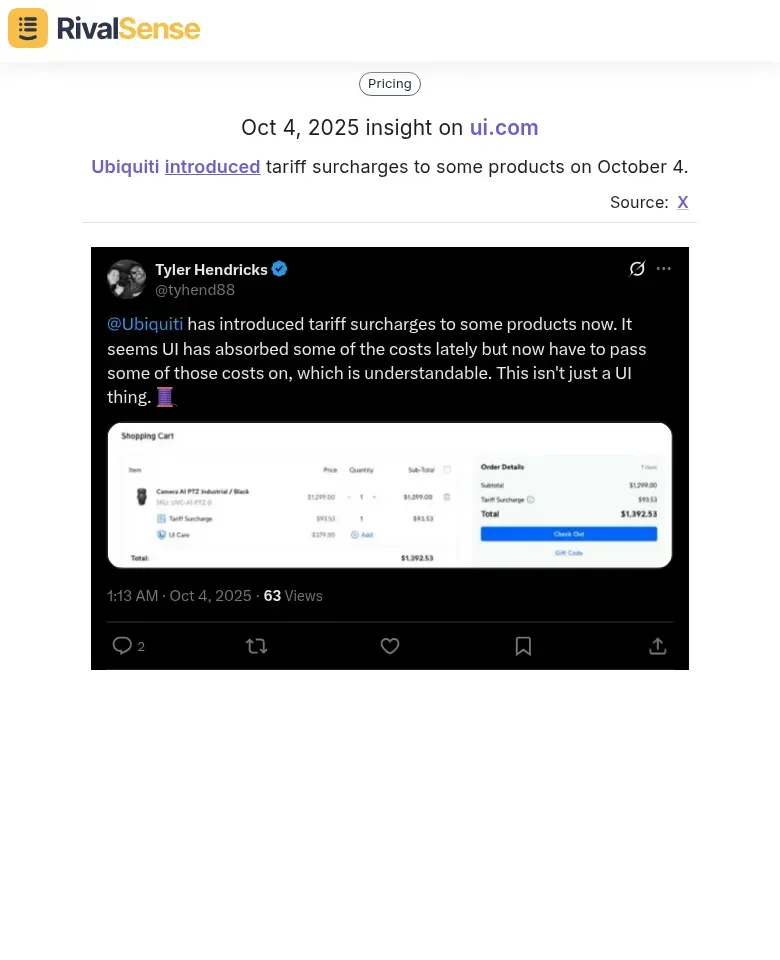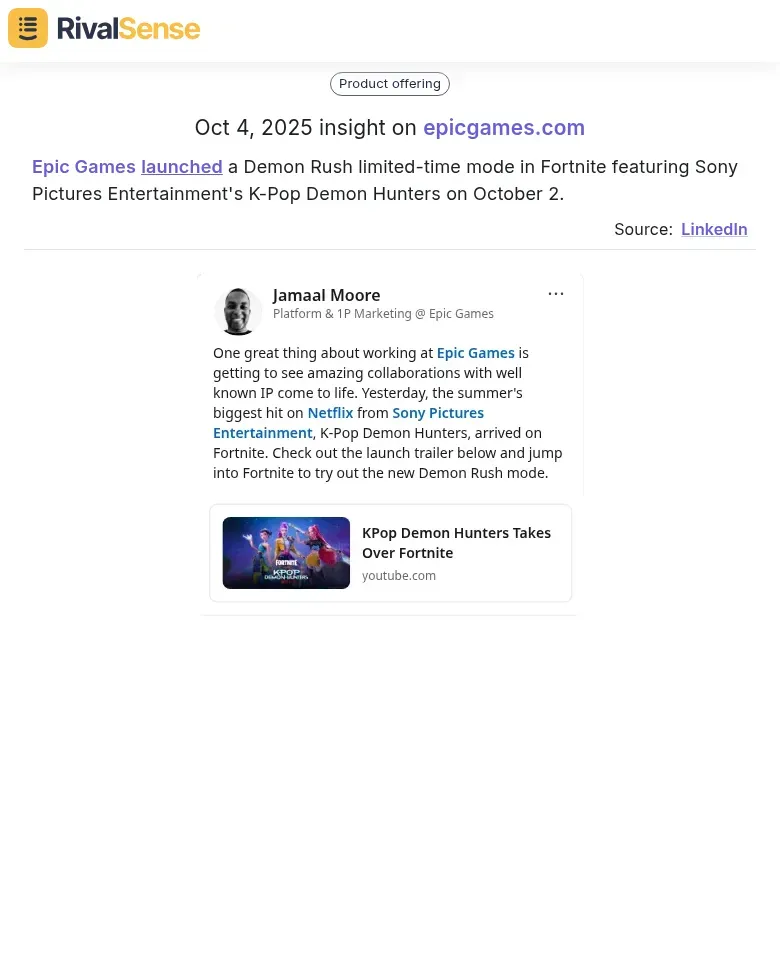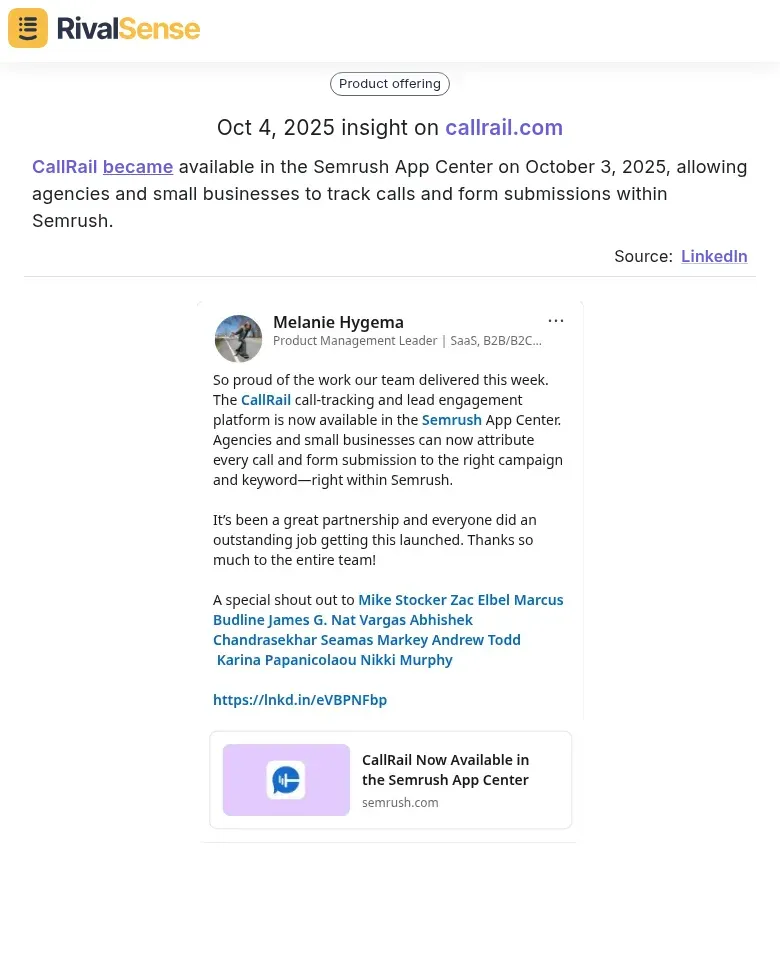Key Account Management Training: Mastering the Miller Heiman LAMP Framework with Modern Tools
Good account management is never an accident. You need a structured process and a plan to follow if you're hoping to hit it big with one or more of your accounts. Over decades, many methodologies have come and gone, but only a few have stood the test of time. One of the most notable is the Miller Heiman Large Account Management Process (LAMP).
The core concepts of LAMP still resonate today: identify your most strategic accounts, align on shared goals, and build long-term partnerships. But while the framework provides the what, modern account teams also need the how. That's where platforms like Kapta—purpose-built for account management—bring the process to life. And in today's competitive landscape, tools like RivalSense can complement this by tracking competitor moves, ensuring your strategies stay ahead.
Who Is LAMP Meant For?
The word "large" in LAMP doesn't necessarily mean your biggest accounts by revenue. Instead, it refers to the accounts most critical to your company's success—the ones you simply can't afford to lose. This distinction makes LAMP applicable to B2B companies across industries and sizes.
For consulting firms, logistics providers, manufacturers, and software companies alike, it's a way to prioritize the customers that matter most. And today, companies that use LAMP alongside modern account management software like Kapta can move beyond theory—turning prioritization into dashboards, health scores, and living account plans that make strategic focus tangible for every team member.
What Is LAMP?
At its core, LAMP is about building deeper partnerships with your most important accounts. Rather than managing all customers the same way, LAMP focuses resources where they can create the highest ROI. It emphasizes a structured approach to segmentation, goal-setting, and execution.
LAMP emphasizes:
- Segmentation – identifying accounts with the most potential
- Goal-setting – aligning on qualitative, shared objectives
- Strategy development – deciding how to invest resources for growth
- Execution – turning goals into measurable objectives and milestones
- Buy-in – securing alignment from executives on both sides
- Review – checking progress regularly (often every 90 days)
This is where Kapta amplifies LAMP. With built-in account segmentation tools, configurable health scoring, strategic account plans, and QBR templates, Kapta operationalizes these LAMP steps into daily workflows. Instead of relying on PowerPoint decks or spreadsheets, teams can see strategy progress, risks, and opportunities in real time.
Practical Steps to Implement LAMP in Your Organization
Step 1: Identify Your Strategic Accounts
Identifying the right accounts is the foundation of LAMP. It requires a data-driven approach to focus on those with the highest strategic value, not just the largest by revenue. This step ensures you allocate resources efficiently and avoid spreading efforts too thin.
- Checklist:
- ✅ List all current accounts by revenue
- ✅ Score each account on strategic importance (0-10)
- ✅ Consider growth potential, industry influence, and partnership value
- ✅ Select top 10-20% for LAMP focus
- Tip: Use tools like RivalSense to monitor competitor account movements—if they're targeting certain clients, those might be strategic for you too.
Step 2: Conduct Deep Account Research
Thorough research helps you understand your accounts' needs, challenges, and opportunities. It involves mapping decision-makers and uncovering insights that can strengthen your partnership. This step is crucial for tailoring your approach and building trust.
- Action Items:
- 🎯 Map decision-makers and influencers
- 🎯 Understand their business objectives and challenges
- 🎯 Identify mutual value opportunities
- 🎯 Document current relationship status
- Hint: Track competitor mentions in your target accounts' communications using competitive intelligence tools to identify potential threats or opportunities.
Step 3: Develop Shared Goals
Setting shared goals ensures both parties are aligned and working towards common outcomes. It transforms the relationship from transactional to collaborative, fostering long-term success. This step involves clear communication and mutual commitment.
- Practical Advice:
- 📅 Schedule joint planning sessions
- 🎯 Create SMART goals (Specific, Measurable, Achievable, Relevant, Time-bound)
- 📝 Document mutual commitments
- 📊 Establish clear success metrics
Step 4: Create Account Plans
Account plans serve as a roadmap for achieving shared goals and managing the relationship effectively. They provide clarity on objectives, actions, and metrics, making it easier to track progress and adapt as needed. A well-crafted plan is dynamic and regularly updated.
- Template Elements:
- 📄 Executive summary
- 🔍 Current state analysis
- 🎯 Strategic objectives
- ⏰ Action plan with timelines
- ⚠️ Risk assessment
- 📈 Success metrics
Step 5: Implement Regular Reviews
Regular reviews keep the partnership on track and allow for timely adjustments. They reinforce accountability and demonstrate your commitment to the account's success. Quarterly business reviews (QBRs) are a common practice in LAMP for this purpose.
- Best Practices:
- 📅 Schedule quarterly business reviews (QBRs)
- 📊 Prepare value demonstration materials
- 👥 Involve executives from both sides
- 📝 Document outcomes and next steps
How Kapta Brings LAMP to Life
Identify and Prioritize the Right Accounts
Not every customer deserves the same level of attention. LAMP calls for focusing on accounts that are most strategic, not just the largest. Kapta helps you operationalize this step by segmenting accounts based on potential, risk, and importance to your growth strategy.
With dashboards that show health scores, engagement, and whitespace, you can clearly see which customers need more investment and which ones are ready for expansion. This data-driven approach ensures your team spends time where it matters most.
Align Goals with Customers and Track Progress Collaboratively
In LAMP, goal alignment is critical—but too often goals are vague or one-sided. Kapta enables you to build shared, measurable goals with your customers inside living account plans. Both your team and your client can see what success looks like and track milestones in real time.
This turns account plans into an active partnership tool instead of a static PowerPoint file. It fosters transparency and keeps everyone aligned on objectives, reducing miscommunication and driving better outcomes.
Spot Risks Early and Take Proactive Action
A key part of account management is reducing churn risk before it becomes a problem. With Kapta's configurable Health Scoring, account managers and RevOps can combine data from usage, satisfaction, and engagement signals into one clear risk indicator.
This makes it easy to see which accounts are stable and which ones need immediate attention. Proactive alerts mean no more end-of-quarter surprises when a renewal is already slipping away, allowing you to address issues before they escalate.
Standardize QBRs That Prove Value and Drive Expansion
QBRs are often run inconsistently and end up being more about reporting than strategy. Kapta standardizes the process with templates, scoring, and centralized tracking so every QBR becomes a chance to prove ROI and explore new opportunities.
Instead of simply checking a box, your team runs meetings that highlight progress on shared goals, uncover whitespace, and set the stage for upsells and cross-sells. This consistent approach builds trust and opens doors for expansion.
Keep Sales, CS, and RevOps Aligned Around One Plan
LAMP emphasizes collaboration, but many companies still operate in silos with disconnected spreadsheets and presentations. Kapta unites Sales, CS, and RevOps on a single platform, with shared visibility into account health, strategy, risks, and growth opportunities.
This eliminates duplication, reduces miscommunication, and ensures every team is pulling in the same direction toward retention and expansion targets. A unified approach streamlines operations and enhances overall efficiency.
Integrating Competitor Intelligence with LAMP
In today's fast-paced business environment, competitor insights are essential for refining your key account management strategies. By monitoring competitor activities, you can anticipate market shifts, identify opportunities, and mitigate risks proactively. Tools like RivalSense provide real-time data that complements the LAMP framework, ensuring your account plans remain responsive and competitive.
Here are practical examples of how competitor insights can enhance your LAMP implementation:
-
Pricing Strategy Insights: When Ubiquiti introduced tariff surcharges to some products on October 4, it highlighted how external factors can impact costs.
 Tracking such changes helps you adjust your pricing strategies for key accounts, ensuring you remain competitive while maintaining margins.
Tracking such changes helps you adjust your pricing strategies for key accounts, ensuring you remain competitive while maintaining margins. -
Product Innovation Monitoring: Epic Games launched a Demon Rush limited-time mode in Fortnite featuring Sony Pictures Entertainment's K-Pop Demon Hunters on October 2.
 This insight shows how competitors engage audiences with new features, which can inspire your own product updates or partnership ideas to better serve strategic accounts.
This insight shows how competitors engage audiences with new features, which can inspire your own product updates or partnership ideas to better serve strategic accounts. -
Partnership and Integration Tracking: CallRail became available in the Semrush App Center on October 3, 2025, allowing agencies and small businesses to track calls and form submissions within Semrush.
 Monitoring competitor partnerships helps you identify ecosystem gaps and opportunities for your own integrations, enhancing value for your key accounts.
Monitoring competitor partnerships helps you identify ecosystem gaps and opportunities for your own integrations, enhancing value for your key accounts.
Is LAMP Still Relevant Today?
Though first introduced in 1991, LAMP's principles are still highly relevant. The sales world has evolved, but the fundamentals of prioritizing strategic accounts, aligning on goals, and reviewing progress remain critical. What has changed is the need for technology to support the process effectively.
Traditional CRMs were designed for pipeline and net-new sales. They don't provide account teams with the structure to run LAMP effectively. That's why more companies are adopting platforms like Kapta to turn frameworks into outcomes—predictable renewals, stronger relationships, and accelerated expansions.
Why Does LAMP Matter?
If your goal is to become a true partner to your top clients rather than just another vendor, LAMP gives you the roadmap. But frameworks only work when they're operationalized consistently. With the right tools and insights, you can transform theoretical concepts into tangible business growth.
With Kapta and competitor intelligence from RivalSense, you don't just study LAMP—you live it:
- ✅ Prioritize the right accounts with data-driven clarity
- ✅ Align on customer goals and track them in real time
- ✅ Catch risks before they become churn
- ✅ Standardize QBRs that prove value and open new revenue
- ✅ Unite your entire team around shared account strategies
- 🔍 Stay ahead of competitor moves to adapt quickly
Final Thought
LAMP is one of the foundational methodologies of Key Account Management. Its relevance today is proof that the fundamentals of customer growth haven't changed: focus, alignment, partnership. The difference lies in how companies leverage modern tools to operationalize these principles.
By combining LAMP with account management software and competitor intelligence, you can retain critical accounts, drive expansion, and create predictable revenue. Ready to enhance your key account management training? Try RivalSense for free at https://rivalsense.co/ and get your first competitor report today to stay informed and competitive!
📚 Read more
👉 Environmental Consulting Key Account Tracking Templates & Frameworks
👉 How VEED's AI Expansion Strategy Outpaced Competitors
👉 Competitor Analysis: Uncover Strategic Insights from Product Launches and Expansions
👉 Competitor Tracking Mastery: Real-World Lessons from Korean Air for B2B Leaders
👉 Gain a Strategic Edge: Track Competitor Media Mentions and Executive Moves
